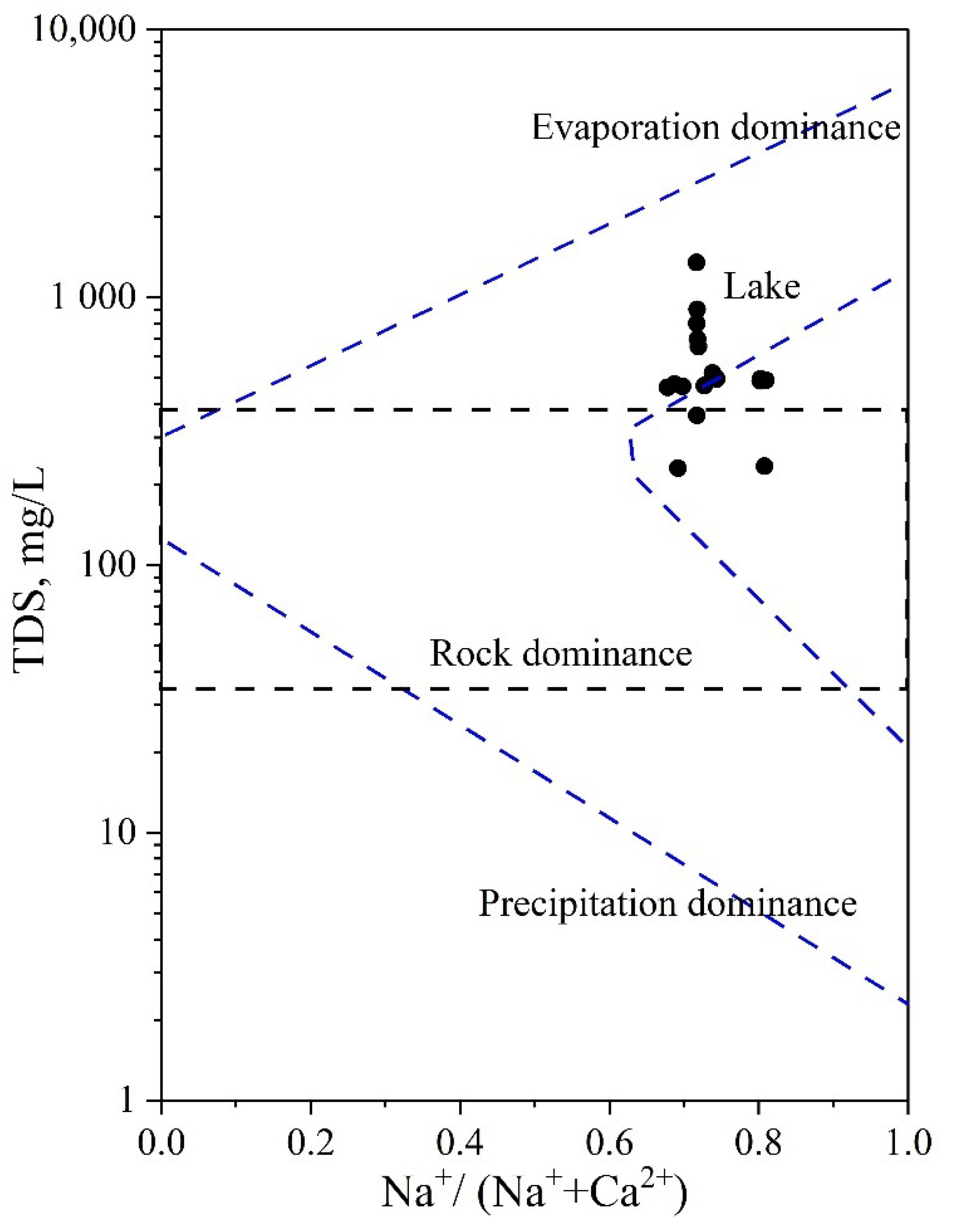Seasonal Variation and Vertical Distribution of Inorganic Nutrients in a Small Artificial Lake, Lake Bulan, in Mongolia
Abstract
1. Introduction
2. Materials and Methods
3. Results
3.1. Physical and Chemical Characteristics of Lake Bulan
3.2. Variation of Nutrients and DOC Concentration and Their Vertical Profiles
3.3. Seasonal Variation of DIN in Lake Bulan
4. Discussion
4.1. Seasonal Variation of Tropic Status in Lake Bulan
4.2. Dynamic of the DIN Profile in Lake Bulan
5. Conclusions
Supplementary Materials
Author Contributions
Funding
Institutional Review Board Statement
Informed Consent Statement
Data Availability Statement
Acknowledgments
Conflicts of Interest
References
- Zhang, Y.; Liang, J.; Zeng, G.; Tang, W.; Lu, Y.; Luo, Y.; Xing, W.; Tang, N.; Ye, S.; Li, X.; et al. How climate change and eutrophication interact with microplastic pollution and sediment resuspension in shallow lakes: A review. Sci. Total Environ. 2020, 705, 135979. [Google Scholar] [CrossRef]
- Rodgers, E.M. Adding climate change to the mix: Responses of aquatic ectotherms to the combined effects of eutrophication and warming. Biol. Lett. 2021, 17, 20210442. [Google Scholar] [CrossRef]
- Kutyavina, T.I. Study of the Processes of Eutrophication of Water Bodies in the Kirov Region. Ph.D. Thesis, Vyatka State University, Vyatka City, Russia, 2017. [Google Scholar]
- Richardson, D. Variability in Water Quality and the Effect of Climate Change and Teleconnections on lake Thermal Structure in the Sky Lakes of Shawangunk Ridge; World Resources Institute: New York, NY, USA, 2017. [Google Scholar]
- Dokulil, M.T.; Teubner, K. Eutrophication and restoration of shallow lakes—The concept of stable equilibria revisited. Hydrobiologia 2003, 506–509, 29–35. [Google Scholar] [CrossRef]
- Jørgensen, E.S. Modelling eutrophication of shallow lakes. Dev. Environ. Model 1988, 12, 177–188. [Google Scholar] [CrossRef]
- Xu, Z.; Xu, Y.J. Determination of trophic state changes with diel dissolved oxygen: A case study in a shallow lake. Water Environ. Res. 2015, 87, 1970–1979. [Google Scholar] [CrossRef]
- Lap, B.Q.; Van Tuan, N.; Hamagami, K.; Iguchi, S.; Mori, K.; Hirai, Y. Formation and disappearance of thermal stratification in a small shallow lake. J. Fac. Agric. Kyushu Univ. 2009, 54, 251–259. [Google Scholar] [CrossRef]
- Woolway, R.I.; Merchant, C.J. Worldwide alteration of lake mixing regimes in response to climate change. Nat. Geosci. 2019, 12, 271–276. [Google Scholar] [CrossRef]
- Shi, J.; Wang, L.; Yang, Y.; Huang, T. Effects of seasonal thermal stratification on ammonia nitrogen transformation in a source water reservoir. Processes 2021, 9, 2218. [Google Scholar] [CrossRef]
- Li, W.; Wu, F.; Liu, C.; Fu, P.; Wang, J.; Mei, Y.; Wang, L.; Guo, J. Temporal and spatial distributions of dissolved organic carbon and nitrogen in two small lakes on the Southwestern China Plateau. Limnology 2008, 9, 163–171. [Google Scholar] [CrossRef]
- Foley, B.; Jones, I.D.; Maberly, S.C.; Rippey, B. Long-term changes in oxygen depletion in a small temperate lake: Effects of climate change and eutrophication. Freshw. Biol. 2012, 57, 278–289. [Google Scholar] [CrossRef]
- Yan, X.; Wang, M.; Xu, X.; Wang, G.; Sun, H.; Yang, Y.; Shi, A. Migration of carbon, nitrogen and phosphorus during organic matter mineralization in eutrophic lake sediments. Hupo Kexue/J. Lake Sci. 2018, 30, 306–313. [Google Scholar] [CrossRef]
- Verburg, P.; Hecky, R.E. The physics of the warming of Lake Tanganyika by climate change. Limnol. Oceanogr. 2009, 54, 2418–2430. [Google Scholar] [CrossRef]
- Ladwig, R.; Hanson, P.C.; Dugan, H.A.; Carey, C.C.; Zhang, Y.; Shu, L.; Duffy, C.J.; Cobourn, K.M. Lake thermal structure drives interannual variability in summer anoxia dynamics in a eutrophic lake over 37 years. Hydrol. Earth Syst. Sci. 2021, 25, 1009–1032. [Google Scholar] [CrossRef]
- Powers, S.M.; Hampton, S.E. Winter limnology as a new frontier. Limnol. Oceanogr. Bull. 2016, 25, 103–108. [Google Scholar] [CrossRef]
- Ozersky, T.; Bramburger, A.J.; Elgin, A.K.; Vanderploeg, H.A.; Wang, J.; Austin, J.A.; Carrick, H.J.; Chavarie, L.; Depew, D.C.; Fisk, A.T.; et al. The changing face of winter: Lessons and questions from the Laurentian great lakes. J. Geophys. Res. Biogeosci. 2021, 126, e2021JG006247. [Google Scholar] [CrossRef]
- Hrycik, A.R. Effects of Changing Winter Severity on Plankton Ecology in Temperate Lakes. Ph.D Thesis, University of Vermont, Burlington, VT, USA, 2021. [Google Scholar]
- Cavaliere, E.; Baulch, H.M. Winter nitrification in ice-covered lakes. PLoS ONE 2019, 14, e0224864. [Google Scholar] [CrossRef]
- Wetzel, R.G. Limology Lake and River Ecosystems, 3rd ed.; Academic Press: Cambridge, MA, USA, 2001; ISBN 9780127447605. [Google Scholar]
- De Haan, H.; Boschker, H.T.S.; Buis, K.; Cappenberg, T.E. Functioning of land-water ecotones in relation to nutrient cycling. Hydrobiologia 1993, 82, 27–32. [Google Scholar] [CrossRef]
- Yang, F.; Li, C.; Matti, L.; Shi, X.; Zhao, S.; Zhang, C. Notable increases in nutrient concentrations in a shallow lake during seasonal ice growth. Water Sci. Technol. 2016, 74, 2773–2783. [Google Scholar] [CrossRef]
- Matveeva, M.O.; Ts Tsybekmitova, G. The dynamics of biogenic elements in the ecosystem of Lake Arakhley (Eastern Transbaikal Region). IOP Conf. Ser. Earth Environ. Sci. 2019, 320, 012032. [Google Scholar] [CrossRef]
- Peryazeva, E.G.; Sanzhanova, S.S.; Zhambalova, D.I. Nutrients, organic matter, and trace elements in Lake Gusinoe (Transbaikalia). Water 2021, 13, 2958. [Google Scholar] [CrossRef]
- Powers, S.M.; Labou, S.G.; Baulch, H.M.; Hunt, R.J.; Lottig, N.R.; Hampton, S.E.; Stanley, E.H. Ice duration drives winter nitrate accumulation in north temperate lakes. Limnol. Oceanogr. Lett. 2017, 2, 177–186. [Google Scholar] [CrossRef]
- Tarasova, E.; Mamontova, E.A. The spatial and time change ability of chemical composition of water of Lake Hovsgol (Mongolia). Environ. Chem. 2017, 26, 87–100. [Google Scholar]
- Paul, M. Limnological aspects of the Uvs Nuur Basin in Northwest. Ph.D. Thesis, Technische Universitat Dresden, Dresden, Germnay, 2012. [Google Scholar]
- Baatar, B.; Chuluun, B.; Tang, S.L.; Bayanjargal, O.; Oyuntsetseg, B. Vertical distribution of physical–chemical features of water and bottom sediments in four saline lakes of the Khangai mountain region, Western Mongolia. Environ. Earth Sci. 2017, 76, 130. [Google Scholar] [CrossRef]
- Dgebuadeze, Y.Y. Limnology and Paleolimnology of Mongolia, 2nd ed.; Biological Resources and Natural Conditions of Mongolia; Joint Russian-Mongolian Complex Biological Expedition RAS and MAS: Moskow, Russia, 2014; Volume 60, pp. 15–20. [Google Scholar]
- Tao, S.; Fang, J.; Zhao, X.; Zhao, S.; Shen, H.; Hu, H.; Tang, Z.; Wang, Z.; Guo, Q.; Turner, B.L. Rapid loss of lakes on the Mongolian Plateau. Proc. Natl. Acad. Sci. USA 2015, 112, 2281–2286. [Google Scholar] [CrossRef]
- Davaa, G. Climate change impacts on water resources in Mongolia. In Proceedings of Consultative Meeting on Integration of Climate Change Adaptation into Sustainable Development in Mongolia; Ulaanbaatar, Mongolia, 17–18 June 2011, Institute for Global Environmental Strategies (IGES): Hayama, Japan, 2011; pp. 30–36. [Google Scholar]
- Ministry of the Environment (Japan). Climate Change in Mongolia, Outputs from GCM; Ministry of the Environment: Tokyo, Japan, 2011; p. 11.
- Orkhonselenge, A.; Komatsu, G.; Uuganzaya, M. Climate-driven changes in lake areas for the last half century in the valley of lakes, Govi region, southern Mongolia. Nat. Sci. 2018, 10, 263–277. [Google Scholar] [CrossRef][Green Version]
- Punsalmaa, B.; Myagmarjav, B.; Batnasan, N.; Jadambaa, N.; Khishigsuren, P. Urban Water Vulnerability to Climate Change in Mongolia; Ministry of Nature, Environment and Tourism, Water Authority: Ulaanbaatar, Mongolia, 2011; p. 71.
- Punsalmaa, B.; Batnasan, N.; Bolormaa, B. Trends in River and Lake Ice in Mongolia. AIACC Working Papers. 2004. Available online: www.start.org/Projects/AIACC_Project/working_papers/Working%20Papers/AIACC_WP_No004.pdf (accessed on 17 May 2022).
- Hofmann, J.; Hürdler, J.; Ibisch, R.; Schaeffer, M.; Borchardt, D. Analysis of recent nutrient emission pathways, resulting surface water quality and ecological impacts under extreme continental climate: The Kharaa River Basin (Mongolia). Int. Rev. Hydrobiol. 2011, 96, 484–519. [Google Scholar] [CrossRef]
- Alonso, M.; Foronda, M.; Palau, A.; Nergui, S.; Pretus, J.L.; Erdenebileg, S. Limnological Catalog of Mongolian Lakes. Available online: http://oslo.geodata.es/mongolian_lakes/index.php?page=home&lang=en (accessed on 20 September 2019).
- Institute of Veterinary Medicine and Institute of Biology at the Mongolian Academy of Sciences. Study of Pond Fish, Viruses, Parasites, Bacteria Disease; Mongolian Academy of Sciences: Ulaanbaatar, Mongolia, 2018; p. 81. [Google Scholar]
- Wang, W.; Ma, Y.; Feng, Z.; Narantsetseg, T.; Liu, K.B.; Zhai, X. A prolonged dry mid-Holocene climate revealed by pollen and diatom records from Lake Ugii Nuur in central Mongolia. Quat. Int. 2011, 229, 74–83. [Google Scholar] [CrossRef]
- Environmental Information Centre at the Ministry of Nature, Environment and Turism of Mongolia Home Page. Available online: http://119.40.97.68:8080/geonetwork/srv/eng/catalog.search#/home (accessed on 5 January 2022).
- MNS:45861998; Water Quality: General Requirements. Mongolian Agency for Standardization and Metrology of Mongolia: Ulaanbaatar, Mongolia, 1998; p. 4. Available online: https://estandard.gov.mn/standard/v/3394 (accessed on 5 January 2022).
- Boehrer, B.; Schultze, M. Stratification of lakes. Rev. Geophys. 2008, 46, RG2005. [Google Scholar] [CrossRef]
- Song, S.; Li, C.; Shi, X.; Zhao, S.; Tian, W.; Li, Z.; Bai, Y.; Cao, X.; Wang, Q.; Huotari, J.; et al. Under-ice metabolism in a shallow lake in a cold and arid climate. Freshw. Biol. 2019, 64, 1710–1720. [Google Scholar] [CrossRef]
- Khuan, Z.Z. Trophic Status of Fresh-Water Lakes in China. Ph.D Thesis, Russian State Hydrometeorological University, St. Petersburg, Russia, 2013. [Google Scholar]
- Wang, W.; Zheng, B.; Jiang, X.; Wang, S. Characteristics and source of dissolved organic matter in Lake Hulun, a large shallow eutrophic steppe lake in Northern China. Water 2020, 12, 953. [Google Scholar] [CrossRef]
- Stepanova, I.E.; Bikbulatova, E.M. Importance of the biogenic element form ratio for assessing the current status of the Ry- binsk Reservoir. Povolzhkiy Ecol. J. 2015, 3, 330–337. [Google Scholar]
- Ye, L.; Cai, Q. Spring phytoplankton blooms in Xiangxi Bay of Three Gorges Reservoir spatiotemporal dynamics across sharp nutrient gradients. J. Freshw. Ecol. 2011, 26, 11–18. [Google Scholar] [CrossRef]
- Maberly, S.C.; Pitt, J.A.; Davies, P.S.; Carvalho, L. Nitrogen and phosphorus limitation and the management of small productive lakes. Inl. Waters 2020, 10, 159–172. [Google Scholar] [CrossRef]
- Johnson, T.C.; Eisenreich, S.J. Silica in Lake Superior: Mass balance considerations and a model for dynamic response to eutrophication. Geochim. Cosmochim. Acta 1979, 43, 77–92. [Google Scholar] [CrossRef]
- Tsegmid, B. Diatom richness in the temporal and spatial variability of biotopes in Khara River catchment, Mongolia. Inl. Water Biol. 2022, 15, 122–128. [Google Scholar] [CrossRef]
- Williamson, C.E.; Morris, D.P.; Pace, M.L.; Olson, O.G. Dissolved organic carbon and nutrients as regulators of lake ecosystems: Resurrection of a more integrated paradigm. Limnol. Oceanogr. 1999, 44, 795–803. [Google Scholar] [CrossRef]
- Khatun, S.; Iwata, T.; Kojima, H.; Ikarashi, Y.; Yamanami, K.; Imazawa, D.; Kenta, T.; Shinohara, R.; Saito, H. Linking stoichiometric organic carbon-nitrogen relationships to planktonic cyanobacteria and subsurface methane maximum in deep freshwater lakes. Water 2020, 12, 402. [Google Scholar] [CrossRef]
- Wei, Y.; Zhang, M.; Cui, L.; Pan, X.; Liu, W.; Li, W.; Lei, Y. Winter decomposition of emergent macrophytes affects water quality under ice in a temperate shallow lake. Water 2020, 12, 2640. [Google Scholar] [CrossRef]
- Jaeger, D. Effects of hypolimnetic water aeration and iron-phosphate precipitation on the trophic level of Lake Krupunder. Hydrobiologia 1994, 275–276, 433–444. [Google Scholar] [CrossRef]
- Bengtsson, L.; Ali-Maher, O. The dependence of the consumption of dissolved oxygen on lake morphology in ice covered lakes. Hydrol. Res. 2020, 51, 381–391. [Google Scholar] [CrossRef]
- Yembuu, B. The Physical Geography of Mongolia; Yembuu, B., Ed.; Springer Nature: Cham, Switzerland, 2021; ISBN 9783030614331. [Google Scholar]
- Ma, C.; Mwagona, C.P.; Yu, H.; Sun, X.; Liang, L.; Al-Ghanim, K.A.; Mahboob, S. Spatial and temporal variation of phytoplankton functional groups in extremely alkaline Dali Nur Lake, North China. J. Freshw. Ecol. 2019, 34, 91–105. [Google Scholar] [CrossRef]
- Maberly, S.C.; O’Donnell, R.A.; Woolway, R.I.; Cutler, M.E.J.; Gong, M.; Jones, I.D.; Merchant, C.J.; Miller, C.A.; Politi, E.; Scott, E.M.; et al. Global lake thermal regions shift under climate change. Nat. Commun. 2020, 11, 1232. [Google Scholar] [CrossRef] [PubMed]
- Sharma, S.; Blagrave, K.; Magnuson, J.J.; O’Reilly, C.M.; Oliver, S.; Batt, R.D.; Magee, M.R.; Straile, D.; Weyhenmeyer, G.A.; Winslow, L.; et al. Widespread loss of lake ice around the Northern Hemisphere in a warming world. Nat. Clim. Chang. 2019, 9, 227–231. [Google Scholar] [CrossRef]







| Station Name | Coordinate | Description | |
|---|---|---|---|
| N | E | ||
| Bulan 1 | 49°31′5″ | 105°54′49″ | 7 m water depth |
| Bulan 2 | 49°30′52″ | 105°54′47″ | 9 m water depth |
| Bulan 3 | 49°30′42″ | 105°54′47″ | 7 m water depth |
| Bornuur | 48°26′48″ | 106°13′8″ | Upper reaches of Kharaa River basin, area 0.25 km2, 4.6 m water depth |
| Ugii | 47°46′17.35″ | 107°46′29.89″ | Khangai Mountains, area 25.7 km2, 15 m water depth |
| Parameter | 30 April 2022 | 27 August 2020 | 24 September 2021 | 25 February 2022 |
|---|---|---|---|---|
| WT, °C | 8.03 * | 20.1 | 14.8 | 0.1 |
| pH | 8.08 | 9.06 | 8.23 | 6.99 |
| DO, mg/L | 16.8 | 2.78 | 4.72 | 4.00 |
| EC, mS/m | 84.1 | 76.6 | 72.2 | 100 |
| Turbidity, NTU | 12.1 | - | 15.5 | 4.00 |
| Sampling Date | Concentration, mg/L | |||||
|---|---|---|---|---|---|---|
| SiO2-Si | DOC | |||||
| 3 January 2020 | 0.64 ± 0.07 | 0.71 ± 0.11 | 0.02 ± 0.004 | 0.03 ± 0.01 | 1.59 ± 0.83 | 7.81 ± 0.82 |
| 30 January 2021 | 0.49 ± 0.04 | 0.91 ± 0.08 | 0.05 ± 0.005 | 0.09 ± 0.07 | 2.69 ± 0.37 | 6.19 ± 0.28 |
| 30 April 2020 | 0.09 ± 0.02 | 0.68 ± 0.01 | 0.02 ± 0.000 | 0.002 ± 0.001 | 0.85 ± 0.16 | 5.82 ± 0.14 |
| 27 August 2020 | 0.19 ± 0.07 | 0.06 ± 0.035 | 0.005 ± 0.001 | 0.003 ± 0.00 | 1.63 ± 0.09 | 6.19 ± 0.28 |
| 27 September 2019 | 0.25 ± 0.06 | 0.10 ± 0.04 | 0.03 ± 0.01 | 0.034 ± 0.009 | 2.21 ± 0.33 | - |
| 24 September 2021 | 0.48 ± 0.10 | 0.18 ± 0.01 | 0.06 ± 0.002 | 0.016 ± 0.003 | 1.38 ± 0.11 | 9.44 ± 0.68 |
| Country | Lake | Lake Type | Altitude (m) | Area (km2) | Water Depth (m) | Sampling Time | Reference | |||||
|---|---|---|---|---|---|---|---|---|---|---|---|---|
| Mongolia | Khuvsugul | Deep freshwater lake | 1645 | 2760 | 138 | Seasonal range | 0.006–0.03 | 0.005–0.001 | 0.0001–0.0026 | 0.002–0.006 | 2008–2011 | [26] |
| Ugii | Shallow freshwater lake | 1332 | 25.7 | 6.6 | August | 0.004 | 0.1 | 0.001 | 0.005 | 2020 | This study | |
| Bornuur | Shallow freshwater | 1007 | 0.25 | 1.6 | September | 0.032 | 0.031 | 0.001 | 0.003 | 2019 | This study | |
| Bulan | Shallow freshwater lake | 678 | 0.45 | 7 | January | 0.49 ± 0.04 | 0.91 ± 0.09 | 0.05 ± 0.006 | 0.08 ± 0.07 | 2020–2021 | This study | |
| April | 0.09 ± 0.02 | 0.68 ± 0.01 | 0.02 ± 0.0 | 0.002 ± 0.001 | ||||||||
| August | 0.18 ± 0.07 | 0.005 ± 0.001 | 0.06 ± 0.04 | 0.003 ± 0.0 | ||||||||
| September | 0.48 ± 0.11 | 0.18 ± 0.01 | 0.06 ± 0.00 | 0.02 ± 0.01 | ||||||||
| China | Wuliangsuhai | Shallow freshwater lake | 1019 | 305 | 1.5 | Winter | 0.46 ± 0.05 | - | - | - | 2017 | [43] |
| Keluke | Plateau freshwater lake | 2817 | 54.7 | 5 | Annual average | 0.5 | 0.009 | 0.007 | 0.039 | 1999 | [44] | |
| Hulun | Inland brackish lake | 545.6 | 2339 | 5.75 | October | 0.19 ± 0.04 | - | - | - | 2018–2019 | [45] | |
| March | 0.20 ± 0.08 | - | - | - | ||||||||
| May | 0.24 ± 0.13 | - | - | - | ||||||||
| July | 0.16 ± 0.04 | - | - | - | ||||||||
| Russia | Arahley | Shallow freshwater lake | 965 | 54 | 10.2 | Annual average | 0.002–0.004 | 0.25–0.74 | 0.005–0.035 | 0.009–0.014 | 2008–2009 | [23] |
| Gusinoe | Shallow freshwater lake | 88.3 | 164 | 2–4 | Winter | 0.003 ± 0.003 | 0.09 ± 0.11 | - | 0.006 ± 0.005 | 2016–2018 | [24] | |
| Spring | 0.009 ± 0.007 | 0.12 ± 0.08 | - | 0.001 ± 0.002 | ||||||||
| Summer | 0.007 ± 0.006 | 0.09 ± 0.08 | - | 0.003 ± 0.002 |
Publisher’s Note: MDPI stays neutral with regard to jurisdictional claims in published maps and institutional affiliations. |
© 2022 by the authors. Licensee MDPI, Basel, Switzerland. This article is an open access article distributed under the terms and conditions of the Creative Commons Attribution (CC BY) license (https://creativecommons.org/licenses/by/4.0/).
Share and Cite
Baterdene, A.; Nagao, S.; Zorigt, B.; Ochir, A.; Fukushi, K.; Davaasuren, D.; Gankhurel, B.; Munkhsuld, E.; Tsetsgee, S.; Yunden, A. Seasonal Variation and Vertical Distribution of Inorganic Nutrients in a Small Artificial Lake, Lake Bulan, in Mongolia. Water 2022, 14, 1916. https://doi.org/10.3390/w14121916
Baterdene A, Nagao S, Zorigt B, Ochir A, Fukushi K, Davaasuren D, Gankhurel B, Munkhsuld E, Tsetsgee S, Yunden A. Seasonal Variation and Vertical Distribution of Inorganic Nutrients in a Small Artificial Lake, Lake Bulan, in Mongolia. Water. 2022; 14(12):1916. https://doi.org/10.3390/w14121916
Chicago/Turabian StyleBaterdene, Ariunsanaa, Seiya Nagao, Baasanjav Zorigt, Altansukh Ochir, Keisuke Fukushi, Davaadorj Davaasuren, Baasansuren Gankhurel, Enkhuur Munkhsuld, Solongo Tsetsgee, and Ariuntungalag Yunden. 2022. "Seasonal Variation and Vertical Distribution of Inorganic Nutrients in a Small Artificial Lake, Lake Bulan, in Mongolia" Water 14, no. 12: 1916. https://doi.org/10.3390/w14121916
APA StyleBaterdene, A., Nagao, S., Zorigt, B., Ochir, A., Fukushi, K., Davaasuren, D., Gankhurel, B., Munkhsuld, E., Tsetsgee, S., & Yunden, A. (2022). Seasonal Variation and Vertical Distribution of Inorganic Nutrients in a Small Artificial Lake, Lake Bulan, in Mongolia. Water, 14(12), 1916. https://doi.org/10.3390/w14121916







